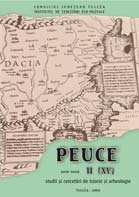Contribuţii privind ceramica romană de la Durostorum (IV)
Contributions concerning the Roman ceramic from Durostorum (IV)
Author(s): Crişan Muşeţeanu, Dan ElefterescuSubject(s): Archaeology
Published by: Institutul de Cercetari Eco-Muzeale Tulcea - Institutul de Istorie si Arheologie
Keywords: Moesia Inferior; Durostorum; epocă romană; ceramică romană; cuptor; Moesia Inferior; Durostorum; Roman epoch; Roman pottery; potter’s stove
Summary/Abstract: Continuing the series of studies about the Roman pottery from Durostorum (Muşeţeanu, Elefterescu 1985, 1989, 1992) the authors present the ceramic material, most of which had been thrown away, discovered among the rest of a potter’s stove in 1999 and marked as C 19. The stove is rectangular, has a central pillar and both the burning point and the heating chamber are made of spared clay. The stove was 80% preserved. One can notice the way the platform is built up and sustained by clay-made beams, with lots of chaff that have a half-round structure, set up this was in order to increase the resistance on the edge. This kind of system can only found rarely in books. After that, the destination of construction was altered and it was used as an opened platform for several other things. As most of the ceramic material collected, the stove is also made of fragments with fit in as aspect and constitution of the paste in group 4. We must also mention the existence of 5 pots made of a rough paste, placed in group 9. We have presented the archaeological considering the morphological type, no matter the size or the function and we’ve tried to identify its connection with the production from C19. Only a few pieces, morphologically speaking, belong to the category of deposed and presenting-pots. In the category of the drinking pots there are 40 pieces, all belong to the same kind of drinking glass. Most of the pieces (or at least those that had been thrown away) consists of presenting pots and serving pots (bowls/a, dishes/b, cups/c). All the elements (the structure of the forms, similar to the ceramic collections from Pannonia Inferior and Moesia Superior but with some differences such as the short period of functioning, the handicraftsman’s mobility, and the technological deficiencies) lead us to the following idea: the stove has functioned at the beginning of the settlement (the first half of the 2nd century B.C.), and the owner or the employee comes from one of the Danubian areas of Panonnia and Moesia (and it was probably influenced by the traditions from that region).
Journal: Peuce (Serie Nouă) - Studii şi cercetari de istorie şi arheologie
- Issue Year: II/2004
- Issue No: 2
- Page Range: 95-142
- Page Count: 48
- Language: Romanian

